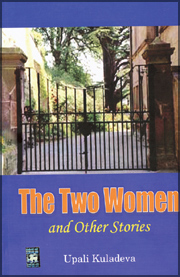|
Stories within storiesFICTION: In the most accepted manner, a short story is denoted as a narrative of limited length. But there seems no strict rule, as there exists stories, which are long as well as short for thousands of years even before the art of writing was known. Some short stories have been retold from folk traditions, and have become popular over the decades. The six stories written by Upali Kuladeva titled The Two Women And Other Stories (Stamford 2006) are quite long and come closer to short novels or nouvellas.
The most striking factor regarding all these six stories is that they are narratives with clear plot outlines or human experiences seen from different points of view. Perhaps the craftsmanship of the story telling art is grasped by the writer that a common reader may feel how wonderful and fascinating his incidents are. Though they are undoubted by human situations, one may wonder at times whether they could happen in actual day-to-day life. Take for instance the first story "A Way of Life", where a father, a Mathematics academician, who looks more like a recluse, leaves his wife, and two children to a distant place, and leads a life cut off from them for twenty years. Later on the son comes to know of a person who could be identified as his father and leaves home in search of him. This encounter of the father and the son and the reluctant revelation looks like a meeting destined and beyond the general materialistic plane of belief. But still the reader is gripped on to the situations, opening new vistas such as the motherly kindness, with a supreme sense of spiritualism and the soul searching phenomenon akin to humans down the centuries. NarratorReading this story, I felt that the narrator or the persona in the narrative, intends to evoke a sense of suspense, which in the end, transcends the mere barriers of make belief, presenting a web of complex human experience hidden from the outer layer existence. In this direction, the writer Kuladeva is a story teller, who has a human story to present whether you believe in it or not intermixed in various existential fantasies. The story titled "The Two Women" is yet another example of the same type. The young girl in the story Nirupama, had the chance of visiting a certain nunnery with a group of members in her circle of living to which she eventually joins as she faces a marital disaster where she becomes a victim of circumstances she reveals her tragedy to the chief nun, who admits her to the nunnery. The very same Chief Nun too has a story of real life of hers, which is also presented, and the two events are made to be compared. The healer has her own tragic story, and the one who is healed clarifies her stance by circumstantial reconciliation. The main story has two stories, one within the other, and they could either be regarded as a single entity or two stories linked to each other. Kuladeva, the writer possesses a repertoire of human stories to narrate and they are mostly drawn from the marital life, and filial intimacies. He has the knack to present them with meticulous care, and minute details. He selects diametrically opposed characters and events to fuse each other in his outer narrative structure consisting of a series of episodes. Here is a series of inner thoughts, and dramatized human situations pinpointing spiritual insights. In all his stories there is a tragic overtone shadowed by human frailties. Two brothersOne classic example is the story titled "The Two Brothers", where the reader observes two brothers who happen to inherit the father's wealth; one becoming quite rich while the other achieves a certain degree of wealth, but remains unhappy, and repentant. Though they engage in the same type of business, one is a loser, and a victim of circumstances, while the other a winner but at the same time a repenter for his own actions. One sensitive area created by the writer is the character of the brother whose factory got burned and the after effects it causes to an individual who so becomes a prey to self denial via suicide. Here too the reader is taken round with a number of human episodes with a touch of suspense and fantasy. The magic realism in the narrative is that though the two brothers have become enemies due to social circumstances, one of them had left a legacy to the other which comes like a surprise through a lawyer. In fact the pivotal effect is the magical layer in the narrative, which is a revelation of the inner nature of the characters. The writer seems to be stating that the mere monetary gains and the happiness it causes to humans is not the ultimate goal of living. The story titled "A Spectre from the Past", according to my observation, is the best narrative in the collection: the central life of a medical doctor and his young wife. Both of them had come to meet each other as medical students in the Medical Faculty. While the events unfold from one point to another, the attention of the reader is drawn towards a special patient, about whom the protagonist doctor takes a special care over the others. He goes to see her, the patient and comes late in the day, which causes trouble to the young wife who later discovers that the patient had been one of the chief benefactors in the life of the doctor, about whom a revelation in the usual manner of narration is presented. The reader as well as the young wife discovers that the patient who is a young wife of a mason and an admirer of the young man, who was destined to be a medical doctor, is presently a victim of cancer. The sympathy is drawn towards the patient over and above other nuances of their day-to-day life. In all the stories of Kuladeva, the reader finds a prisoner of conscience, trapped in a manner with difficulties of getting out of it. Kuladeva, the writer, creator has his own manner of story telling, which is closer to the orientalistic pattern of narration, rather than the imitation of the modernistic genres of the West. Reading through these six stories, I felt that I am in the middle of reading some Buddhist legends that revolve round characters like Devadatta, Nalagiri, Magandi, and Patacara. I agree with Professor Ashley Halpe when he says: "Our attention is directed to some unusual potentiality or predicament and its working out is achieved through situations and interactions which express hidden depths in the characters involved." |
|
.................................. |









